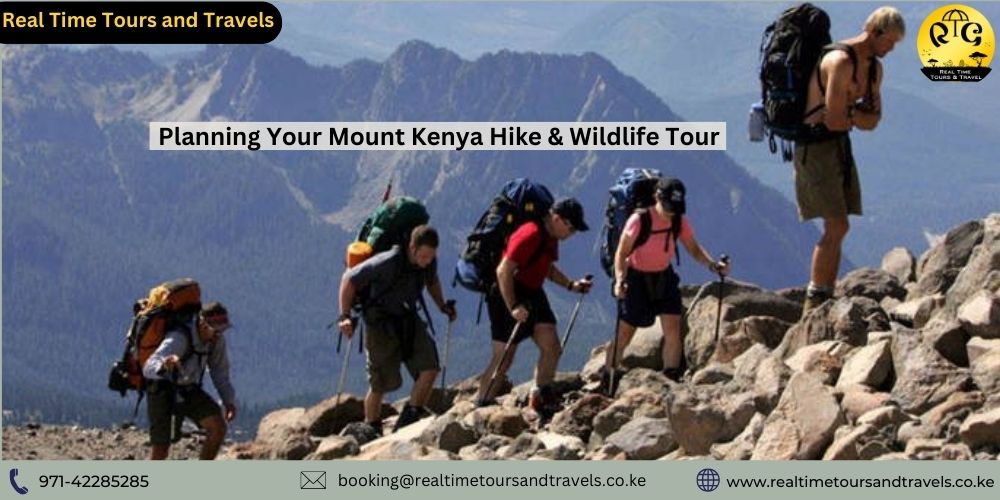From rocky, volcanic to steep, hilly terrains, Kenya is home to an incredible array of hiking paths. They offer a range of topographies and degrees of difficulty. You will always be surrounded by breathtaking views because of Kenya’s diverse geography. Adventures at Mount Kenya Hike & Wildlife Tour can be found on every climb, struggle, and stroll, from stunning open savanna plains to the summits of rugged peaks and mountainous mountains.
One of the best outdoor activities is hiking. Hiking is a great pastime, but it can also be intimidating and stressful for first-timers. In Kenya, it’s not the most leisurely activity. Hiking can be difficult and unpleasant if you lack the required equipment, abilities, or confidence. You can hike more easily and learn everything you need to know with the help of the below advice.
Why Should You Go Mount Kenya Hike & Wildlife Tour?
Best Mount Kenya Tours and trekking offers people an exceptional chance to get some exercise. To study and commune with nature, you can detach yourself from the pressures of everyday existence. Walking, trekking, and exploring have been popular pastimes for Kenyans in recent times.
Weekends and holidays are the busiest times for their travel. Domestic tourism is growing, according to travel operators that provide low-cost weekend packages that include hiking and sightseeing.
Beginner-Friendly Hiking Trails
Give yourself a straight assessment of your experience and degree of fitness before selecting a hiking route. It’s okay to push yourself, but be aware that doing so might be harmful to your health. You also run the danger of not enjoying hiking as much as before, as it will be a negative experience. Start with the simpler trails and work your way up if you’ve never gone hiking before. If you choose to hike a more challenging path, go at your own pace. Depending on how fit you are, pick a hike.
Weather Conditions
When planning a trip, it is imperative to keep an eye on the weather. Remember that the weather can change quickly, especially in the Highlands. Your travel will be impacted by rain or excessively hot weather. Before you go, make sure to ask your guide about the weather.
Use sunscreen if you want to go trekking on a hot day. Start your trek early in the morning to avoid hiking under the scorching midday sun. You will likely be heading straight into the sun because many hiking paths in Kenya are somewhat shaded.
This trek is best suited for experienced hikers, and guests should pack appropriate equipment and guides. Because of the terrain, the distance, the cold, and the thin air caused by elevation fluctuations, it is difficult. It is recommended that individuals prepare their bodies for the climb by working out a few weeks before. Because it is neither overly challenging or convoluted, the Kakamega Forest hiking track is ideal for novice hikers.
The Surroundings
Kenya is a fairly varied country with a wide range of topography. Parks and nature trails tend to be flatter and simpler to travel than mountains, which are usually steeper. Craters with steep sides and a level summit are also known to exist.
Hiking difficulty is dependent on a variety of factors, including terrain, soil, and plant species. Mount Elgon boasts several moorland areas and minor summits with amazing views. Geothermal springs, caverns, and woods are all located on the mountain. With the assistance of several local guides, hikers can select a trail and an itinerary.
What Not to Wear
When dressing for hiking, comfort is crucial. Never wear jeans! The ability to remove specific pieces in hot weather and re-wear them in cold winter makes layering an indispensable wardrobe accessory.
Wear airy, light clothes that dries quickly when the weather is warm. Keep in mind to wear a cap or hat. You can wear shorts and tank tops as well, but to avoid the sun, you should wear long sleeves and long pants or leggings. Better still if you can get some UV protection gear. Exercise gear is fine for day excursions to popular locations.
Self-handling
Go at your own speed while walking. If you hike slowly, don’t be scared of others who hike faster. Don’t forget to stay in your lane. Observe your body carefully, pausing when required.
Stop for a moment and enjoy the flowers, wildlife, and beauty. You don’t get to spend much time in nature (unless you live in such regions), so make the most of any opportunity you get. Enjoy the peace and quiet of nature, take in the fresh, pure air, and stay in the present.
Packing Food and Snacks for a Day Walk
You’ll be burning calories on the trip, so the meals and snacks you pack should be high in fat and protein. You can have eggs, yogurt, or oatmeal for breakfast before the climb. Nuts like peanuts, granola, fruits (including apples, bananas, oranges, and tangerines), and protein or energy bars are healthy snack options.
Trekking in the heat requires consuming salty snacks and drinking lots of water to replace the electrolytes lost via perspiration. It is essential that you pack at least three liters of water. Single-use plastic bottles and containers should not be brought, and if you do, please do not leave them on the paths.
Kenya’s climbing season runs from July to October. In Kenya, the months of March through May or June see heavy downpours, followed by October, November, and December seeing sporadic showers. Because of the wet trails, cloud cover, and chilly weather, people avoid hiking during the rainy season.





